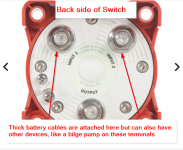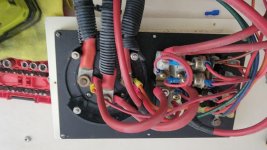rickasbury
Master Chief Petty Officer
- Joined
- Jul 13, 2011
- Messages
- 810
I have always had a battery issue. I did the following test on the system.
As far as checking, multimeter on 10 amp max setting. Ignition is off- battery switch is off. I have not rechecked battery 2 but it was dead 0 on the draw. The only thing I'm sure i should have done but did not was taking the genset off. Not sure why I think that but would make sense to rule it out. So, the test is remove the neg cable and test between the post and the cable.
The radio is dead and will not turn on. I do not know if the amp is on or not - 4 amps though?
Battery switch during test is off.
As far as other electrical issues-
The spot light is not operating. I thought the control head was bad and replaced it. It was going up and down but now it does nothing. I did not pull the two blade fuses but assume this is not going to be a draw.
No tv plugged in..radio off. No bilge pumps running. As mentioned the sump pump is bad or jammed up- i cut the wires to it.
I guess pulling fuses and find the circuit it is comming from?
As far as checking, multimeter on 10 amp max setting. Ignition is off- battery switch is off. I have not rechecked battery 2 but it was dead 0 on the draw. The only thing I'm sure i should have done but did not was taking the genset off. Not sure why I think that but would make sense to rule it out. So, the test is remove the neg cable and test between the post and the cable.
The radio is dead and will not turn on. I do not know if the amp is on or not - 4 amps though?
Battery switch during test is off.
As far as other electrical issues-
The spot light is not operating. I thought the control head was bad and replaced it. It was going up and down but now it does nothing. I did not pull the two blade fuses but assume this is not going to be a draw.
No tv plugged in..radio off. No bilge pumps running. As mentioned the sump pump is bad or jammed up- i cut the wires to it.
I guess pulling fuses and find the circuit it is comming from?






















